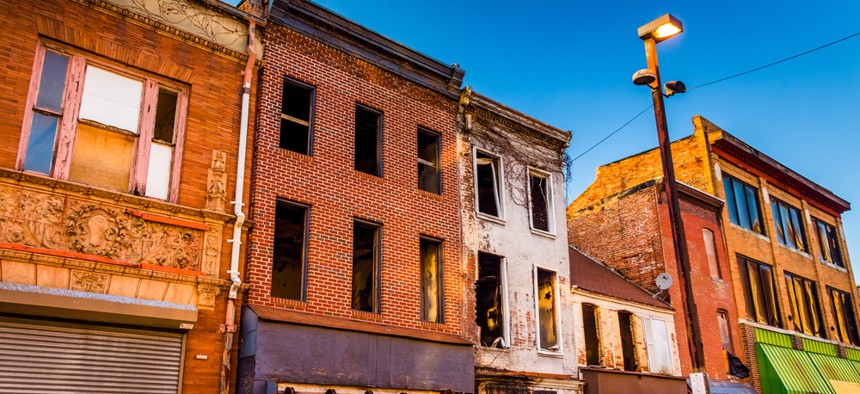Can Homeless People Move Into Baltimore's Abandoned Houses?

Jon Bilous / Shutterstock.com
There are more than 16,000 vacant homes in the city. Are they the solution to the long-standing housing crisis?
Jeremiah, who is 28 and used to work in landscaping, didn’t have anywhere to live during the frigid cold of last winter. So one night, when the shelters of Baltimore were full, he ducked into an alley near downtown Baltimore, where an abandoned house had a “For Sale” sign on it. The back door was open, so he let himself in and went to sleep.
There was gas and electricity but no water, and he kept the lights off so no one would see he was living there. And no one seemed to mind. So he came back the next night and then the next, using the home to keep warm until spring came, although he’d turn off the gas at night since he was worried about leaks.
“They need to fix up these homes that we have here,” he said, sitting under a highway bridge in downtown Baltimore, a navy blue hooded sweatshirt snugly covering his head. He now sleeps in a tent under the bridge, alongside dozens of other homeless people, some in wheelchairs, others who have come draggingmattresses or couches upon which to lay their heads. Loitering in a vacant home in Baltimore can get you arrested, and though he misses the warmth, Jeremiah didn't want to take the chance, so he moved out of his adopted home when the weather got warmer.
But one group in Baltimore is pushing to help others do officially what Jeremiah did on the fly: take vacant homes and turn them into permanent affordable housing for the homeless. Housing Our Neighbors, part of the Housing Is A Human Right Roundtable, is made up of labor activists, homeowners, and homeless people. The group is currently surveying the McElderry Park neighborhood in Baltimore in order to present the city with a report on the number of vacant homes there. They say the data will show there are far more vacant homes in Baltimore than the city has previously acknowledged, and they argue that those homes should be turned into affordable housing.
“Clearly there’s a moral crisis when you see so many people in need of homes and there’s such a glut of vacant ones,” said Rachel Kutler, a leadership organizer with United Workers, which works with the Roundtable.
I went along with Tony Simmons, who is homeless, on a tour through a neighborhood the group recently surveyed. Simmons, 53, is wiry and energetic, and talks constantly about vacant homes, the project, and his own history. He served in Operation Desert Storm, after which he spent some time as a drug runner, driving cars filled with drugs between cities on the Eastern Seaboard, partially so he could fund the heroin habit that was taking over his life. Now, though he’s kicked his habit and has thrown himself into activism for the homeless, although he doesn’t yet have his own home.
We start at the church where the group meets before it begins its surveys, and walk down an alley where vacant homes have been turned into a community garden. Crossing a busy street, Simmons points out a deflated helium balloon tied around a telephone pole alongside a photo of a smiling teenager marking a spot where someone had been shot and killed.
Some of the homes we pass seem almost new, others are sagging, their paint peeling. Simmons has an eye for which ones are too far gone to save, and which are uninhabited, even if they don't have plywood on their windows and doors.
“This house is perfect—the windows are intact, the doors are intact, the foundation is strong and there’s no leaking in the basement,” Simmons says, in front of one home, with gray and tan bricks on its facade and a bright plywood board on the door. “Yet it’s all boarded-up.”
There are more than 16,000 vacant homes in Baltimore, according to the city. About 30,000 people in the city will experience homelessness over the course of the year, 3,000 on any given night. That’s partially because Maryland, one of the richest states in the union, has some of the least affordable housing in the country. A minimum-wage worker in Maryland would have to work 138 hours a week to afford a two-bedroom unit at fair-market rent, according to the National Low-Income Housing Coalition.
NEXT STORY: Why New Yorkers Can't Find a Taxi When It Rains





